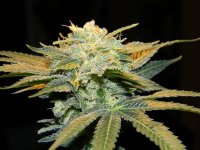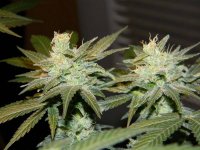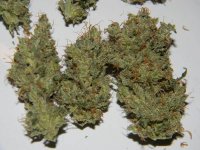So i would like to list my recipe and see what constructive critisism I can get. So I am going off basic knowledge, nothing scientific and it sounded like a good recipe. It has not hurt any of my plants at all, but I have only fed to one strain so far. Here ya go:
In a 5 gal bucket:
-2.5 gal water
-2tsp Mexican bat guano
-2tsp peruvian bat guano
-2tsp seabird guano
-1/2cup comfrey meal
-1/2 cup alfalfa
-2tsp blackstrap molasses
I have an air pump for a 60 gallon aquarium hooked up to 2 air stones, both 6". The water is from the tap set out at least 24hrs and PH balanced to about 6.0-6.2
I "brew" for about 2 days, strain through cheesecloth. Mix 2.5 gals of tea to 2.5 gals clean water, and feed. The only strain i used it on was Blueberry Funk, a sativa dominant hybrid. It turned out absolutely amazing. The issue though is I have not grown that strain without the tea, so..... ya haha.
So, what do you guys think about the tea? Should I consider adding more ingredients? Apprciate the help!
SONNN
In a 5 gal bucket:
-2.5 gal water
-2tsp Mexican bat guano
-2tsp peruvian bat guano
-2tsp seabird guano
-1/2cup comfrey meal
-1/2 cup alfalfa
-2tsp blackstrap molasses
I have an air pump for a 60 gallon aquarium hooked up to 2 air stones, both 6". The water is from the tap set out at least 24hrs and PH balanced to about 6.0-6.2
I "brew" for about 2 days, strain through cheesecloth. Mix 2.5 gals of tea to 2.5 gals clean water, and feed. The only strain i used it on was Blueberry Funk, a sativa dominant hybrid. It turned out absolutely amazing. The issue though is I have not grown that strain without the tea, so..... ya haha.
So, what do you guys think about the tea? Should I consider adding more ingredients? Apprciate the help!
SONNN






